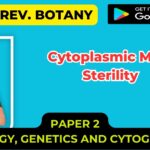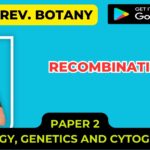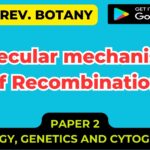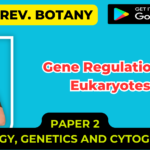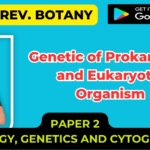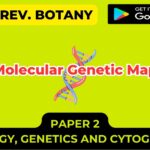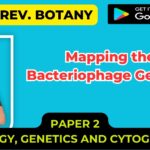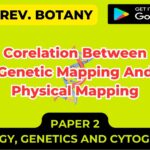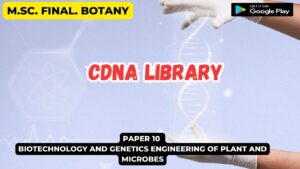Construction of Molecular Map
- Preparation of linkage map based on recombination data is always handicapped due to non-availability of mutants for many genes.
- This limitation has largely been overcome in recent years by molecular mapping through ISH (in situ hybridization), Restriction mapping, RFLP (Restriction Fragment Length Polymorphism) analysis, RAPD (Random Amplified Polymorphic DNA) technique, Minisatellites and microsatellites (VNTR) study.
- Molecular maps are both physical and genetic.
Molecular Physical Map:
(a) In Situ Hybridization (ISH: FISH & GISH):
- For localization and mapping of different segments of chromosomes and gene loci at the microscopic level, application of molecular hybridization in situ is now widely adopted (Fig. 22.13A).
- In situ hybridization (ISH) principally uses probe sequences, tagged with radioisotopes or fluorescent compounds (or a chemical reporter).
- The initial step is denaturation of the target which is followed by hybridization with probe of the complementary sequences to undergo re-annealing or pairing.

- The complementary sequences of the probe bind selectively at the target site.
- The hybridized sites are localized either through autoradiography or immunofluorescence as well as counter staining with specific stains detected cytologically.
- The in situ hybridization technique was developed initially by Pardue and Gall and later modified by different authors.
- The fluorescent in situ hybridization (FISH) is the most powerful technique at present, through which the target loci at the chromosome is hybridized with complementary probe sequence, tagged with fluorescent compound.
- There are two approaches, namely direct or indirect, of FISH technique in plant chromosome.
- In the indirect method, the probes are tagged with reporter molecule, such as biotin, digoxigenin and finally they are located by fluorochrome conjugated antibodies such as avidin.
- The main principle of this method is to make the probe-target sequence as antigenic so that, it can be detected through antibody.
- The common fluorochromes are FITC (fluorescein-isothiocyanate) as well as rhodamine.
- In the direct method, the probe is directly labelled by fluorochrome-labelled antibodies.
- The direct labelling of fluorochrome with the probe is the rapid method of ensuring good resolution.
- Due to lack of karyomorphological markers, metaphase chromosome analysis cannot distinguish parental genomes in hybrids.
- If ISH technique is applied with total genomic probes where the plant has multi-genomic constitution, the parental chromosome can be directly identified in the hybrids, such as
- Triticum and Secale in Triticale or in the hybrid of Gasteria and Aloe (Fig. 22.13B).

- Thus method of total genome in situ hybridization is otherwise termed as GISH (genomic in situ hybridization) technique.
- Since its first demonstration in identification of parental genomes in hybrid between Hordeum chilense and Secale africanum by Schwarzacher et al., the technique has been extensively applied to elucidate ancestry of hybrids and polyploids.
- GISH remains a very effective tool in genome identification, their orientation and in establishing genomic relationships between species.
- The use of GISH in meiosis helps in understanding inter-genomic homologies as well as in elucidating the possible transfer of chromosome segments through inter-genomic recombination.
- The FISH technique, using different colour combinations by different probes, is now being applied to detect simultaneously different genomes, or chromosome segments by extension of the technique—otherwise termed as multi-colour FISH.
- This method has been used to distinguish three genomes in hexaploid wheat and to detect several translocation sites and insertions in polyploid species of Triticum and Aegilops.
- The multi-colour FISH technique is now regarded as a powerful tool for gene mapping as well as detection of abnormalities, including insertion and breakage points with chromosome specific or genome specific dispersed probes.
- The term chromosome painting is used in FISH technique where chromosome specific dispersed probes are used to detect the location of complementary target sequences in the complement.
- The FISH technique in recent years has further been modified to locate single copy or tandem sequences, utilizing primer mediated extension and amplification in situ by PCR method.
- The application of this method lies also in confirmation of location of foreign gene at the chromosome level in transgenic individuals.
(b) Restriction Mapping:
- Determination of nucleotide sequence of a gene is done by cleavage of corresponding DNA at specific sites with the help of restriction endonucleases.
- These sites of cleavage can be identified and mapped to give to a restriction map.
- On a restriction map, is found a linear sequence of sites, each for a specific enzyme and the distances between them are measured as number of base pairs of DNA (Fig. 22.14).
- The data of digestion of a DNA molecule by more than one endonucleases can be utilized to arrange the sites of breakage in a definite order.

- This process involves double digests (enzyme A and B) to determine the cleavage positions of DNA due to one enzyme with respect to another enzyme.
- The results of reciprocal digests (A followed by B and B followed by A) show the same fragments.
- The original DNA sample is also digested by a mixture of both the enzymes to confirm the results of individual successive digests.
- Overlapping region of different digests (A and B) can be detected which allow to prepare the restriction map.
(c) Other Methods:
Following methods are also used for this purpose.
(i) Chromosome Walking:
- It is a technique where different sequential clones from a genomic library are identified by successive hybridization and restriction maps are prepared separately.
- As a result the whole chromosomal regions are characterized and restriction map of entire chromosome can be prepared following the technique of chromosome walking.
(ii) Chromosome Jumping:
- Chromosome jumping approach to construct the physical map is utilized in order to bring the molecular marker close to the gene of interest.
- This technique will minimize the size of the DNA segments carrying the gene to be cloned in comparison to the used linked molecular marker.
(iii) Radiation Hybrid Mapping:
- The radiation hybrids are somatic cell hybrids in which an irradiated fragment of human DNA is randomly integrated into the rodent chromosomes.
- After screening a panel of hybrid clones with a human marker allows the marker to be mapped.
(iv) QTL Mapping:
- A QTL (Quantitative trait loci) may be defined as a region of the genome that is associated with an important quantitative agronomic trait.
- The QTL mapping is an advanced method using RFLP maps.
- It exploits the complete linkage maps by interval mapping of ‘QTL’ and identifies the crosses for QTL mapping.
- The effect of each genome segment located between a pair of marker loci (but not QTL associated with a single RFLP) is assessed by interval mapping.

